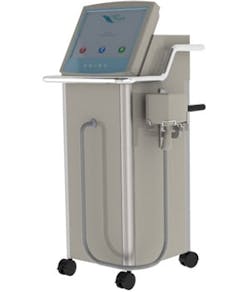CANCER DETECTION/GYNECOLOGY: Device helps remedy false positive/negative diagnoses
In November 2009, the American College of Obstetrics and Gynecologists (ACOG) recommended later onset and less frequency for routine Pap tests, which check for cervical cancer in women. The ACOG did so "not because screening is so expensive," says Mark L. Faupel, Ph.D., president and CEO of Guided Therapeutics (Norcross, GA), but because follow-up to an abnormal test result is expensive. Like many, however, Faupel feels that scaling back screenings is not the right approach. He says, "Our solution is better technology."
That's because current methods are not reliable in the first place: They tend to miss disease and create false positives (and repeated attempts to tweak haven't improved them much). That fact has been demonstrated–most recently by a just-concluded FDA pivotal clinical trial for Guided Therapeutics' LightTouch Cervical Neoplasia Detection System, a non-invasive, hyperspectral imaging spectroscopy (HIS)-based approach to detecting cervical cancer.
Details of the trial will be reported at the American Society for Colposcopy and Cervical Pathology annual meeting in March. It was conducted at seven U.S. clinics with an enrollment of approximately 2000 women, all of whom were deemed at risk for developing cancer because of an abnormal Pap, human papillomavirus (HPV) test, colposcopy, or some other factor. The trial showed that the current methods missed nearly a third of cervical precancers and cancers. And of the biopsies performed on patients who tested positive via these methods for cancer or precancer, only 19% indicated presence of the diseases. The trial results correlate well with those of a 2005 study sponsored by the National Cancer Institute (NCI).
Better technology (and less expensive)
According to studies published in the peer-reviewed Journal of Lower Genital Tract Disease, the non-invasive LightTouch test has the potential to be significantly more accurate than the traditional approaches. LightTouch produces results in less than a minute, to provide objective results at the point of care.
The system includes a hand-held device (with a single-use disposable patient interface), which connects to a base unit via fiberoptic cables for bi-directional transmission of light. The base, which resides on a rolling cart, contains a xenon arc lamp, optical processing elements (e.g., filters and lenses), and a CCD camera. A computer provides control and data processing. Faupel says, however, that the "key spec" is the dramatically reduced cost of the technology. Ten years ago the $20,000 system would have cost $60,000 to $100,000.
In fact, cost effectiveness is a major reason Guided Therapeutics has been able to secure approximately $6 million in six consecutive grants from the NCI, says Faupel. Increasing efficiency of low-cost sensors has allowed the company to use lower-cost light sources (which also have become more efficient!). In addition, he says, "our engineers have had prior experience in cost reducing similar technology." (SpectRx, the company that formed Guided Therapeutics as a subsidiary, developed BiliChek, a device that analyzes reflected light shined on an infant's forehead to detect jaundice.)
How, where, when, and more
In a single minute, LightTouch scans a matrix of equally spaced points over a one-inch diameter of the cervical area, acquiring individual spectra for each cell component. For cervical tissue reflectance measurements, light ranging from about 350 to 900nm is applied. For tissue fluorescence measurements, light is bandpass filtered to limit exposure to 300 to 500 nm. Each wavelength is applied automatically under software control in a predetermined order and scan pattern. Output is imaged, processed, and analyzed: Alterations in fluorescence spectra indicate metabolic changes associated with disease, while abnormal reflectance and scattering highlight disease-induced structural changes.
Although LightTouch is perfectly capable of providing initial screening, and will be put to use in that way in other areas of the world (an exciting proposition for developing countries especially), in the U.S. it will be used for follow-up testing of patients deemed at risk.
Since development of LightTouch began, more than 3000 women have been tested with the device, including approximately 2000 who were enrolled in the FDA pivotal clinical trial. The technology has already received a CE mark and is now undergoing FDA premarket review. Guided Therapeutics anticipates a 2010 international launch.
The technology can apply to detection of other forms of cancer, too, and since mid-2007 Guided Therapeutics has been collaborating with Konica Minolta Opto Inc. (Tokyo) to identify large market opportunities. This past May, the partners entered into an agreement to co-develop additional products for the detection of lung and esophageal cancer.
About the Author

Barbara Gefvert
Editor-in-Chief, BioOptics World (2008-2020)
Barbara G. Gefvert has been a science and technology editor and writer since 1987, and served as editor in chief on multiple publications, including Sensors magazine for nearly a decade.
